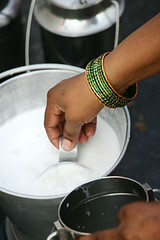
A study of dairy farms in three states of India has found that farmers who adopt milk safety practices receive higher prices from sale of better quality milk.
The study was carried out in the states of Bihar, Punjab and Uttar Pradesh to highlight the status of compliance with food safety measures in the Indian dairy sector at farm level and investigate the relationship between safety compliance and producer price of milk.
The findings are published in the November 2011 online edition of the Journal of International Food & Agribusiness Marketing.
India is currently the world’s largest producer of milk and Bihar, Punjab and Uttar Pradesh are among India’s largest milk-producing states, accounting for 5.5%, 8.9% and 18%, respectively, of national milk production.
The lead author of the article is Dr Anjani Kumar, principal scientist (agricultural economics) at the National Centre for Agricultural Economics and Policy Research in New Delhi and former scientist at the Market Opportunities theme of the International Livestock Research Institute (ILRI). The co-authors are Dr Iain Wright, ILRI's regional representative for Asia and Dr Dhiraj Singh, scientific officer in ILRI's Asia office in New Delhi.
Compliance with milk safety measures at dairy farm level was low and smallholder dairy farmers were found to be less likely to adopt safer milk handling practices than farmers with larger herd sizes.
The study recommends that supporting policies and technologies be put in place to spur the uptake of safer milk handling practices by dairy farmers, particularly smallholder producers who dominate the dairy sector in India.
Policy support by the government is also need to cushion smallholder farmers from the costs of compliance with food safety standards thereby ensuring that they remain competitive in dairy production and marketing.
Read the abstract of the article.
Citation
Kumar A, Wright IA and Singh DK. 2011. Adoption of food safety practices in milk production: implications for dairy farmers in India. Journal of International Food & Agribusiness Marketing 23(4): 330-344.

No comments:
Post a Comment